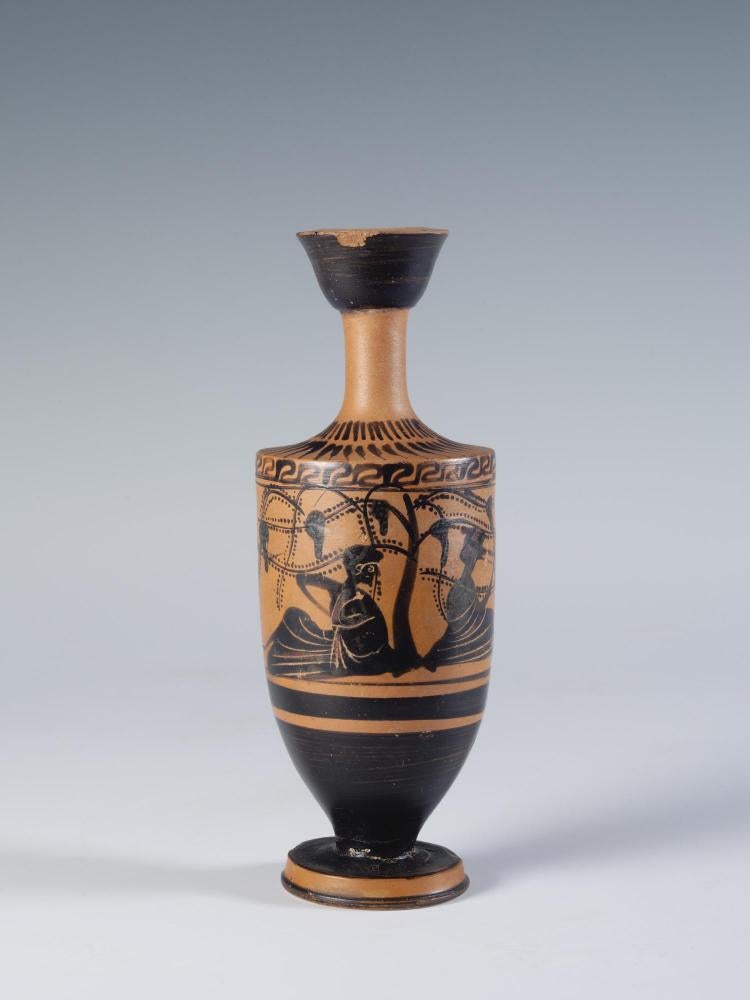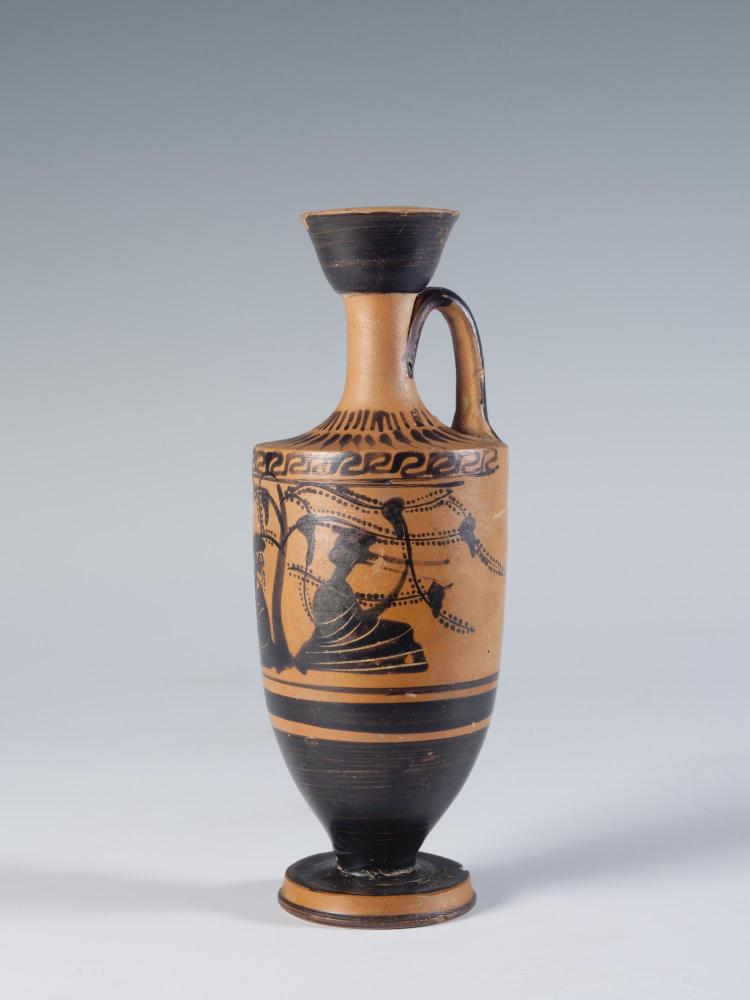2006.25.T, Attic Black-Figure Lekythos
Catalogue Entry 

This vase is one of a collection of Greek vases held by the CU Art Museum.
Gift to CU Classics Department
Transferred to CU Museum of Natural History
Transferred to CU Art Museum (2006)
Height: 15.9 cm
Diameter (max.): 5.7 cm
Date: 5th century B.C.E.
Origin: Attica (Greece)
Description: small black-figure lekythos with round base, relatively squat body, narrow neck, and slightly flared mouth. Body carries image of male figure reclining on a couch beneath a grape arbor. A female figure is seated on the other side of a vine and plays the double flute or aulos. Hastily drawn meander borders scene at top. Bottom portion of body decorated with solid black slip. Top of foot is black, while outer circumference of foot reserved in the color of clay. Shoulder decorated with parallel vertical black lines; shorter parallel vertical black lines encircle the bottom of the neck. Handle and mouth are black.
Additional photos of this vessel show details of the mouth, rim, handle, decoration, and base.
Discussion

Although the black-figure technique of vase painting was most popular in the 6th century B.C.E., this vase was probably painted in the 5th century B.C.E., after the invention of the red-figure technique. The dating of this vase is based on several factors. First, the figural representation of this vase compares favorably with other late black-figure vase paintings, including those by the Antimenes Painter, who worked from about 530 to 510 B.C.E., and the Leagros Group, who were active from about 525 to 500 B.C.E. Second, the quality of the painting, especially the hastily drawn meander and the uneven parallel vertical lines on the neck and shoulder, is relatively low, suggesting that its decoration was rushed, perhaps even mass-produced. Lekythoi were routinely buried in tombs as gifts to the dead and, as a result, a large number have been preserved. Artistically-speaking, many of these lekythoi are of a low quality, especially those in the black-figure technique that were made in the 5th century B.C.E., after red-figure had become dominant (4).
Lekythoi were used by the ancient Greeks to hold oil. The narrow neck of the lekythos was designed so that the flow of oil was limited to a thin stream or perhaps even to drops, while its thick lip prevented spillage (5). Olive oil was valuable in the ancient Greek world. The olive tree was given to the Athenians by their patron goddess Athena. Harvested between November and March, the oil of olives was used for many purposes, including as offerings and dedications for the dead (6), as prizes for victorious athletes (7), as a scented perfume (8), for consumption, and for bathing.
Footnotes
- Andrew J. Clark, Maya Elston, and Mary Louise Hart, Understanding Greek Vases (Los Angeles: J. Paul Getty Trust, 2002): 112.
- Chara Tzavella-Evjen, Greek and Roman Vases and Statuettes from the University of Colorado Collection (Athens: Archaiologikon Deltion, 1973): 194; Maria Ludwika Bernhard, Corpus vasorum antiquorum, Pologne Fasc. 4, Varsovie, Musée national (Warsaw: Panstwowe wydawnictwo nanhowe, 1960): pl. 28, 1-3; Corpus vasorum antiquorum, Deutschland Bd. 4, Braunschweig, Herzog Anton Ulrich-Museum (Munich: Beck, 1940): pl. 10, 18; Corpus vasorum antiquorum, Italia 18, Taranto, Museuo Nazionale ii (Milan: Bestetti e Tumminelli, 1942): pl. 8, 3. ADelt. 21 (1966): Chronika, Pl. 99ß.
- Tzavella-Evjen, Greek and Roman Vases: 195.
- Clark, Elston, and Hart, Understanding Greek Vases: 112.
- Clark, Elston, and Hart, Understanding Greek Vases: 112.
- Christine Bron and François Lissarrague, "Looking at the vase," in ed. Claude Bérard, A City of Images: Iconography and Society in Ancient Greece (Princeton: Princeton University Press, 1989): 18.
- Jenifer Neils, Goddess and Polis The Panathenaic Festival in Ancient Athens (Princeton: Princeton University Press, 1992): 5.
- Clark, Elston, and Hart, Understanding Greek Vases: 112.
References
- Chara Tzavella-Evjen, Greek and Roman Vases and Statuettes from the University of Colorado Collection (Athens: Archaiologikon Deltion, 1973): 192-197.

